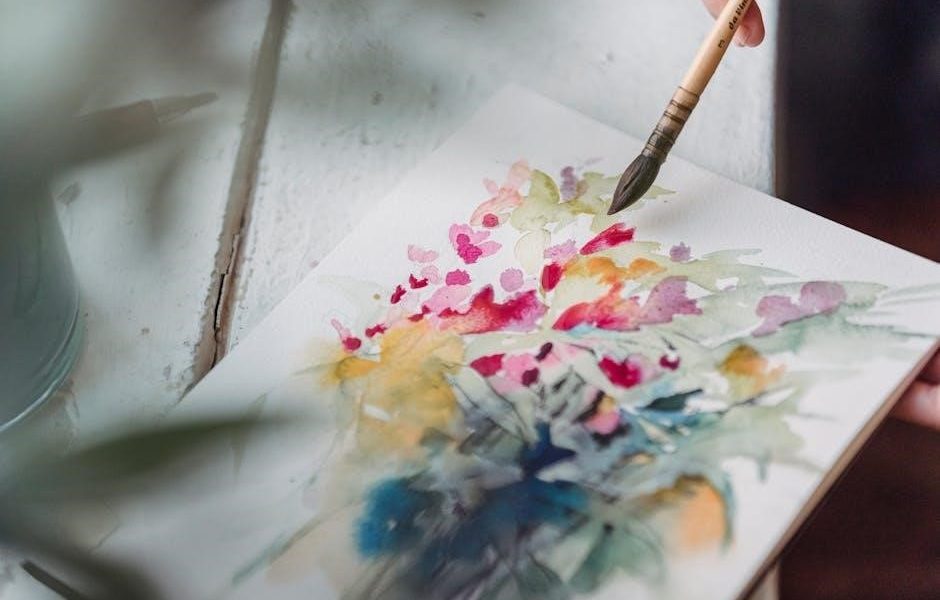
watercolour painting techniques pdf
Watercolour painting is a versatile medium offering unique transparency and fluidity. Popular techniques include wet-on-wet, wet-on-dry, and glazing. Practice and patience are key to mastering these methods, with resources like PDF guides providing step-by-step tutorials for beginners and advanced artists alike.
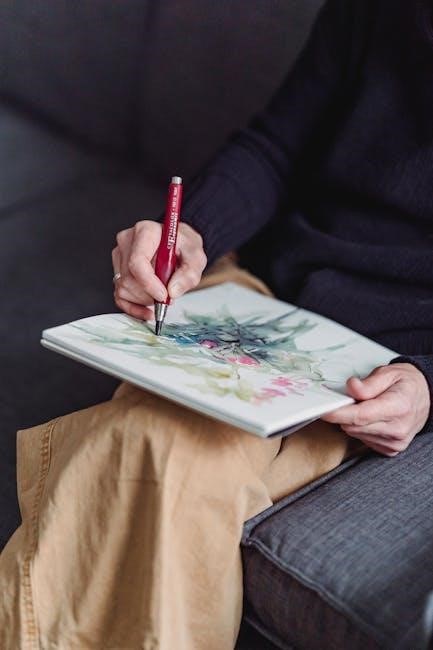
Essential Materials for Watercolour Painting
High-quality brushes, vibrant watercolour paints, durable paper, and practical palettes are core materials. Additional tools like masking fluid and water containers enhance creativity, as detailed in watercolour guides.
Brushes for Watercolour Painting
Brushes are a critical tool in watercolour painting, with natural and synthetic fibers offering distinct effects. Round brushes are ideal for fine details and blending, while flat brushes are best for broad washes. Mop brushes create soft, textured effects, and detail brushes are perfect for intricate work. The choice of brush size and shape depends on the desired technique, from delicate lines to expansive backgrounds. Natural hair brushes, like sable, hold more water, allowing for smoother washes. Synthetic brushes are durable and excellent for bold, expressive strokes. Proper brush care, including regular cleaning and storage, ensures longevity. Many watercolour guides emphasize the importance of experimenting with different brushes to achieve unique effects. Brushes vary in price and quality, catering to both beginners and professional artists. Understanding brush types and their uses is fundamental to mastering watercolour techniques, as detailed in various PDF tutorials and art resources.
Watercolour Paints and Pigments
Watercolour paints are composed of pigments suspended in a binder, typically gum arabic, which adheres the pigment to the paper. High-quality paints have lightfast pigments that resist fading over time, ensuring artworks remain vibrant. Student-grade paints often contain fillers, while professional-grade paints have higher pigment load, offering richer colours. Pan paints are dried and convenient for travel, while tube paints are fluid and ideal for mixing. Natural pigments, derived from minerals and plants, provide unique textures, while synthetic pigments offer consistent results. Understanding pigment characteristics is essential for achieving desired effects. Many PDF guides detail pigment properties and mixing techniques, helping artists select the right materials for their style. Proper pigment selection enhances colour clarity and durability, making it a cornerstone of watercolour painting success.
Watercolour Paper: Types and Sizes
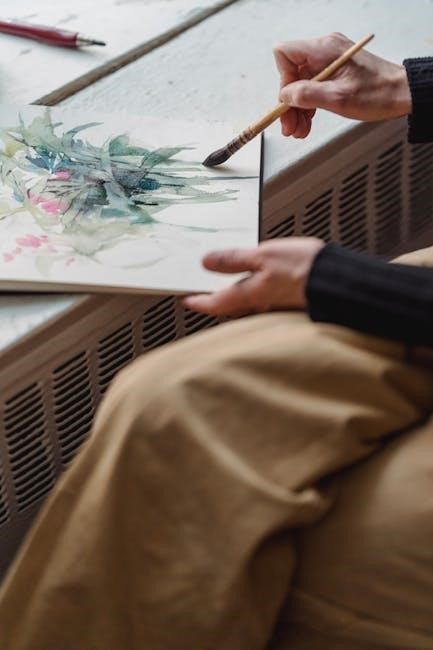
Watercolour paper is a critical component of the medium, available in various textures and sizes to suit artistic needs. Hot press paper offers a smooth surface for fine details, while cold press paper has a textured finish ideal for expressive brushstrokes. Rough paper provides an even more pronounced texture, enhancing organic effects. Papers are often labeled as “Series” grades, such as RHS (Rough, Hot, Smooth), indicating texture and finish. Sizes range from standard sheets to custom cuts, with popular options including A4, A3, and 22×30 inches. Weight is measured in grams per square metre, with 140lb (300gsm) and 200lb (410gsm) being common choices for durability. High-quality, acid-free papers prevent yellowing over time and withstand multiple washes. Many PDF guides recommend selecting paper based on technique and desired effects, ensuring optimal results for watercolour painting projects.
Additional Tools for Watercolour Painting
Beyond brushes and paints, various tools enhance the watercolour painting process. A palette is essential for mixing colours, with disposable and reusable options available. Water containers are crucial for rinsing and blending, while a spray bottle helps maintain paper moisture. Masking fluid, applied with a fine brush, protects areas from unwanted colour. A hairdryer or heat tool accelerates drying between layers. Tissues or paper towels blot excess water, preventing over-saturation. A sharp pencil and eraser are used for sketching and correcting. Some artists employ a maulstick for steady painting. PDF guides often highlight these tools, emphasizing their roles in achieving desired effects. Each tool contributes to the versatility and precision of watercolour techniques, allowing artists to explore a wide range of creative possibilities effectively.
Core Watercolour Painting Techniques
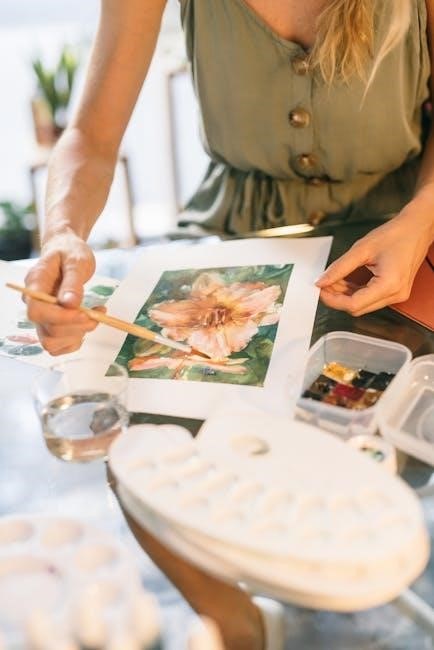
Core techniques include wet-on-wet, wet-on-dry, glazing, and flat washes. Masking fluid and scumbling also enhance effects. These methods, detailed in PDF guides, form the foundation of watercolour artistry.
Wet-on-Wet Technique
The wet-on-wet technique involves applying wet paint to wet paper, creating soft, blended edges and merging colours seamlessly. This method is ideal for capturing subtle shifts in tone and colour, often used for skies or backgrounds. To execute it, moisten the paper with clean water before adding pigment, allowing the paint to spread naturally. Artists can layer additional wet paint to deepen hues or adjust values. This technique requires careful timing, as the paper must remain damp but not overly saturated. Tutorials in watercolour painting PDFs often emphasize the importance of brush control and pigment consistency for successful wet-on-wet applications. It’s a foundational skill that enhances fluidity and spontaneity in watercolour work, making it a favourite among both beginners and experienced artists.
Wet-on-Dry Technique
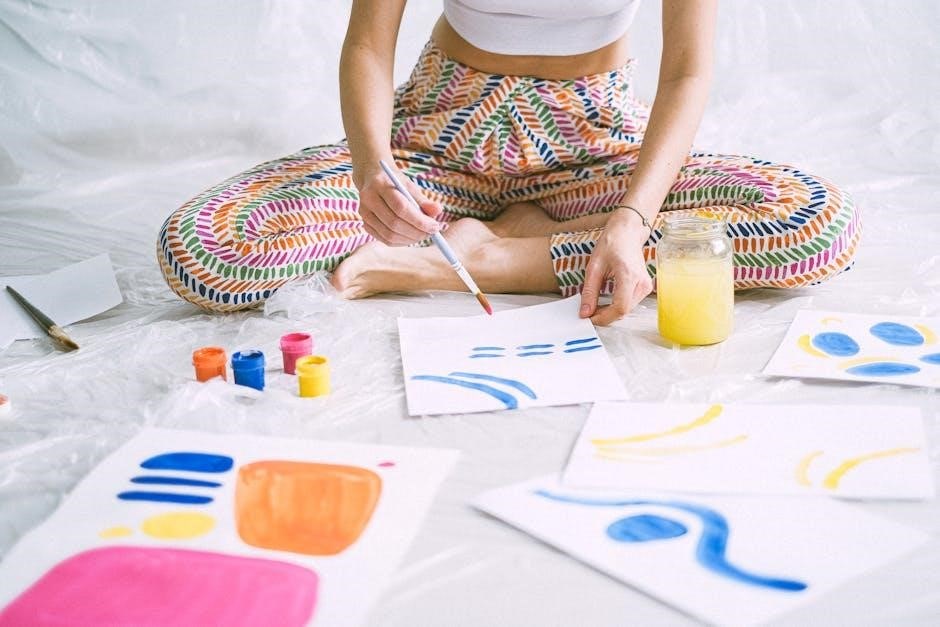
The wet-on-dry technique involves applying wet paint to dry or damp paper, allowing for crisp, defined edges and sharp details. This method is ideal for creating precise forms, such as foliage, flowers, or architectural elements. To use this technique, the paper must be completely dry before adding paint, ensuring the pigment adheres without spreading unpredictably. Artists often use smaller brushes for finer details and thicker paint for bold, opaque strokes. Timing is crucial, as the paint must be applied before the paper dries completely but after it has lost its initial moisture. Tutorials in watercolour painting PDFs frequently highlight this technique for its ability to add texture and contrast to a composition. By mastering wet-on-dry, artists can achieve vibrant, detailed work with excellent control over colour and form.
Flat Wash and Gradated Wash
A flat wash is a uniform layer of paint applied evenly across a section of paper, often used for backgrounds, skies, or large areas of colour. To achieve this, the paper is thoroughly wetted, and paint is spread smoothly with broad, soft-bristled brushes. The gradated wash takes this further by transitioning from one colour to another or from light to dark within the same wash. This technique is ideal for creating soft, atmospheric effects, such as sunsets or misty landscapes. For best results, the paper should remain damp but not soaking wet, allowing the paint to blend seamlessly. Tutorials in watercolour painting PDFs often emphasize these wash techniques for their ability to create depth and harmony in a composition. By mastering flat and gradated washes, artists can achieve smooth, balanced transitions that enhance the overall visual appeal of their work.
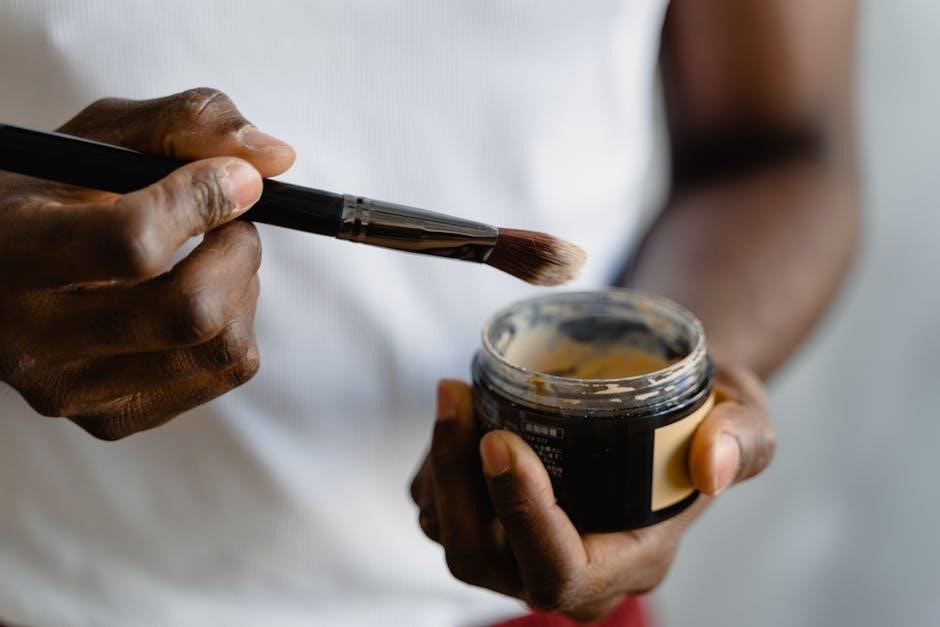
Glazing Technique
The glazing technique involves applying multiple thin, transparent layers of paint to achieve deep, rich colours and intricate details. This method is particularly effective for creating luminous and vibrant hues, as each layer builds upon the previous one. To execute a glaze, the artist mixes a small amount of pigment with water, creating a translucent wash. This wash is then applied over a previously painted area, usually after it has dried completely. The process can be repeated several times to intensify the colour or to add complex tonal shifts. Glazing is especially useful for capturing subtle shifts in light and shadow, as well as for enhancing the depth and dimensionality of a painting. Many watercolour painting PDF guides emphasize the importance of patience with this technique, as each layer must dry thoroughly before the next can be applied. This method is ideal for achieving intricate, detailed work and is often used in botanical and portrait painting. Mastering the glazing technique allows artists to unlock a range of expressive possibilities, from delicate washes to bold, vivid colours. By layering transparent pigments, artists can create works that radiate with depth and luminosity, making the glazing technique a cornerstone of advanced watercolour practice.
Drybrush Technique
The drybrush technique involves dragging a nearly dry brush across the paper to create textured, rough effects. This method is particularly useful for capturing the appearance of grass, tree bark, or other organic surfaces. To achieve this, the brush is blotted on a cloth or paper towel to remove most of the moisture, leaving only a small amount of pigment. The artist then applies gentle to firm pressure, pulling the brush in the desired direction. The result is a series of broken, uneven strokes that mimic the texture of the subject. Many watercolour painting PDF guides highlight the drybrush technique as a versatile tool for adding visual interest and depth to a composition. It is especially effective in landscape and botanical painting, where natural textures are prominent. By experimenting with different brush angles and pressures, artists can achieve a wide range of effects, from subtle suggestions of texture to bold, expressive marks. This technique is a valuable addition to any watercolour artist’s skill set, offering new ways to explore form and detail in their work.
Advanced Watercolour Painting Techniques
Advanced techniques like negative painting and masking fluid create intricate details and luminous effects. These methods, along with scumbling, allow artists to achieve complexity and depth in their work.
Negative Painting
Negative painting involves creating shapes and details by painting around objects. This technique emphasizes the space between subjects, allowing the white of the paper or previously applied colors to define forms. It is particularly useful for capturing delicate textures and intricate details, such as foliage or woven patterns. By carefully layering washes and preserving areas of the paper, artists can achieve a sense of lightness and depth. Negative painting requires precision and foresight, as it often involves working backward from the overall composition. Proper planning is essential to ensure that the unpainted areas effectively convey the intended imagery. This method is especially popular in watercolour due to the medium’s transparency and fluidity, making it ideal for subtle, ethereal effects. With practice, negative painting can add a unique dimension to watercolour works, enhancing both detail and visual interest.
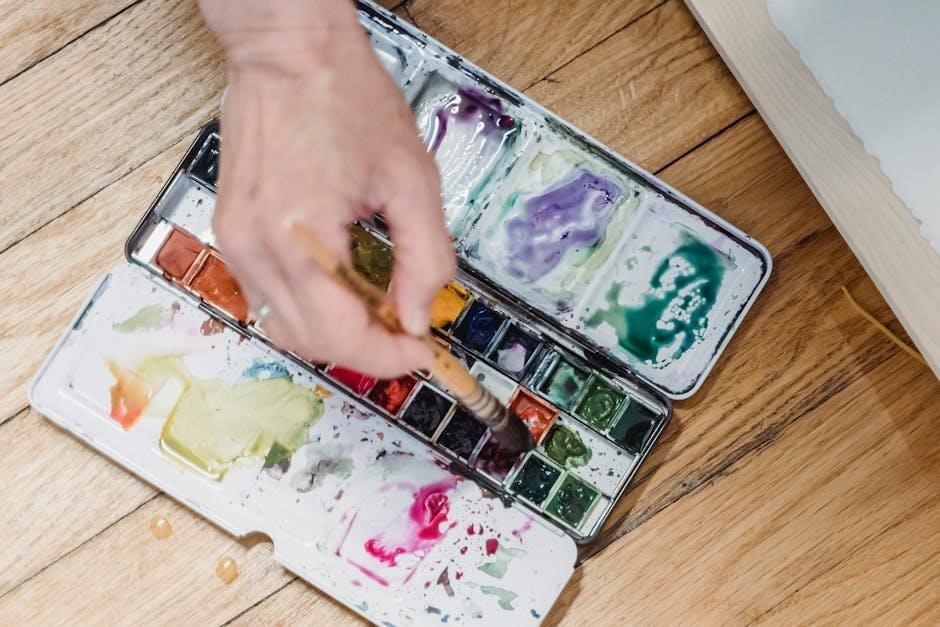
Using Masking Fluid
Masking fluid, also known as masking tape or frisket, is a essential tool for watercolour painting. It allows artists to protect specific areas of the paper from unwanted paint, ensuring crisp, sharp edges and preserving white spaces. Masking fluid is typically applied with a brush or pen to areas that should remain unpainted, such as highlights or fine details. Once dry, it creates a waterproof barrier that resists paint. After completing the painting, the masking fluid is gently peeled off, revealing the protected areas in their original state. This technique is particularly useful for creating intricate designs, preserving delicate whites, and achieving precise details. Masking fluid can be used in combination with other techniques to enhance the overall composition and add visual contrast. Proper application and removal are key to avoiding damage to the paper. With practice, masking fluid becomes a versatile tool for achieving desired effects in watercolour art.
Scumbling Technique
The scumbling technique involves applying a thin layer of paint over a previously painted area to create textured effects. This method is achieved by dragging a almost-dry brush loaded with pigment across the paper. The goal is to allow some of the underlying paint to show through, creating subtle colour shifts and depth. Scumbling is particularly effective for suggesting rough textures, such as stone, bark, or fabric. It adds visual interest and complexity to a painting without completely covering the original layer. Artists often use scumbling to enhance details or create atmospheric effects. Properly executed, this technique can elevate a watercolour piece by adding dimensionality and nuance. Practice is essential to master the balance between paint and water for desired results. Scumbling is a valuable tool for achieving dynamic, layered compositions in watercolour art.
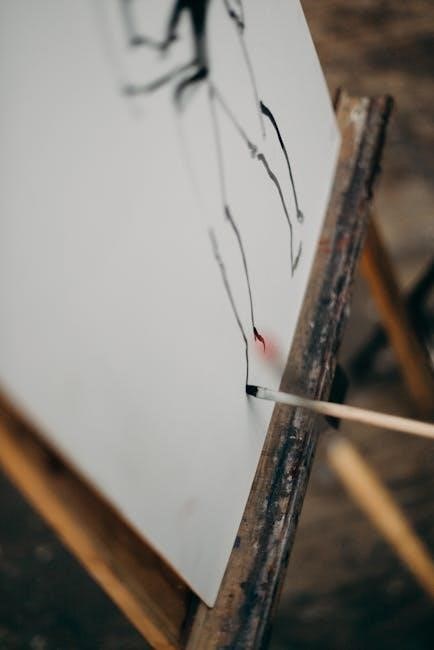
Colour Theory and Pigment Mixing
Colour theory and pigment mixing are fundamental to watercolour painting. Understanding primary and secondary colours, warm and cool hues, and transparency levels helps create vibrant, harmonious palettes and effects.
Understanding Colour Theory Basics
Colour theory forms the foundation of watercolour painting, guiding how colours interact and blend. The colour wheel is a key tool, showing primary colours (red, yellow, blue) and their mixtures into secondary hues (orange, green, violet). Understanding warm colours (like reds and oranges) and cool colours (blues and greens) helps create balance and mood in paintings. Value, or lightness and darkness, and saturation, the intensity of a colour, are also crucial. In watercolours, transparency and layering allow for subtle shifts in tone and depth. Grasping these basics enables artists to mix pigments effectively and achieve desired visual effects, enhancing their creative expression and control over the medium.
Mixing Pigments for Desired Effects
Mixing pigments is a cornerstone of watercolour painting, allowing artists to achieve specific hues and effects. Understanding how colours interact is essential, as watercolours rely on transparency and layering. Start by testing pigment combinations on scrap paper to predict their behaviour. Wet-on-wet and glazing techniques often require precise mixing to maintain vibrancy and depth. A common approach is to mix a dominant pigment with smaller amounts of complementary colours to create balanced, nuanced shades. The ratio of pigment to water also plays a crucial role, with higher concentrations producing richer tones. Avoid overmixing, as this can dull the colours. Instead, allow layers to dry between applications for optimal results. Practice and experimentation are key to mastering pigment mixing, enabling artists to achieve the desired mood and texture in their work.
Composition and Visual Elements in Watercolour
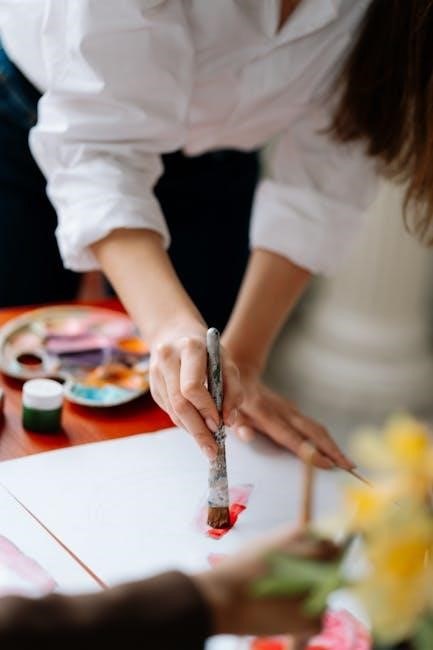
Composition and visual elements are crucial for creating balanced and visually appealing watercolour paintings. Key elements include line, shape, and value, which guide the viewer’s eye and evoke emotion. Understanding how to arrange these elements effectively enhances the overall impact of your artwork, making it more engaging and harmonious. By mastering composition basics, you can direct attention to focal points and create a cohesive visual narrative, ensuring your watercolour paintings are both aesthetically pleasing and thought-provoking.
Understanding Composition Basics
Understanding composition basics is fundamental to creating visually appealing watercolour paintings. Composition involves arranging visual elements like line, shape, and value to guide the viewer’s eye and evoke emotion. Key principles include balance, harmony, and the rule of thirds, which help create dynamic yet cohesive artwork; By planning your composition beforehand, you can ensure that each element serves a purpose, leading to a more engaging piece. Sketching your design on paper before painting helps refine your ideas. Paying attention to negative space and focal points also enhances the overall impact. Learning these foundational principles allows you to experiment with more complex arrangements, ensuring your watercolour paintings are both aesthetically pleasing and thoughtfully composed. Mastery of composition basics is essential for transforming simple ideas into captivating works of art.
Visual Elements: Line, Shape, Value
Line, shape, and value are essential visual elements in watercolour painting. Lines create movement and direction, guiding the viewer’s eye through the composition. They can be bold or delicate, depending on the desired effect. Shapes, whether geometric or organic, form the structural foundation of your artwork, defining forms and spaces. Value refers to the lightness or darkness of colours, creating depth and contrast. By mastering these elements, you can achieve balance and harmony in your paintings. Understanding how to use lines to suggest form, shapes to create stability, and value to evoke mood is crucial for artistic expression. These fundamental elements work together to convey meaning and emotion, making them indispensable tools in watercolour painting. Practicing their application helps refine your skills and enhances the visual impact of your work.
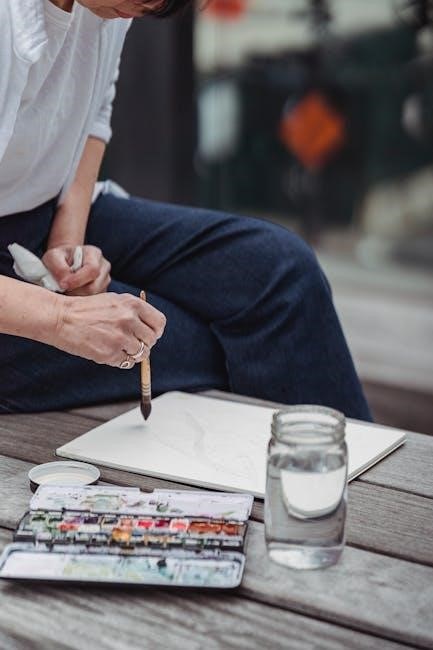
Practice Exercises and Projects
Practice exercises involve creating technique samples and simple paintings. Step-by-step tutorials and downloadable PDF guides offer structured learning. These resources suit both beginners and experienced artists.
Step-by-Step Watercolour Tutorials
Step-by-step watercolour tutorials are designed to guide artists through specific painting techniques and projects. These tutorials often include detailed instructions, images, and downloadable resources like PDF guides. Many tutorials focus on teaching foundational skills, such as wet-on-wet and wet-on-dry methods, while others explore advanced techniques like glazing and negative painting. Beginners can benefit from exercises that demonstrate brush control, pigment mixing, and wash application. Advanced artists can refine their skills with tutorials on complex compositions and texture manipulation. Some tutorials also provide printable templates for tracing, allowing artists to practice without the pressure of creating their own designs. Whether focusing on realistic wildlife, landscapes, or abstract art, these tutorials offer structured learning opportunities. They are ideal for self-paced learning, helping artists build confidence and mastery in watercolour painting.
Related posts:
Archives
Calendar
| M | T | W | T | F | S | S |
|---|---|---|---|---|---|---|
| 1 | 2 | 3 | 4 | 5 | 6 | 7 |
| 8 | 9 | 10 | 11 | 12 | 13 | 14 |
| 15 | 16 | 17 | 18 | 19 | 20 | 21 |
| 22 | 23 | 24 | 25 | 26 | 27 | 28 |
| 29 | 30 | 31 | ||||
Leave a Reply
You must be logged in to post a comment.